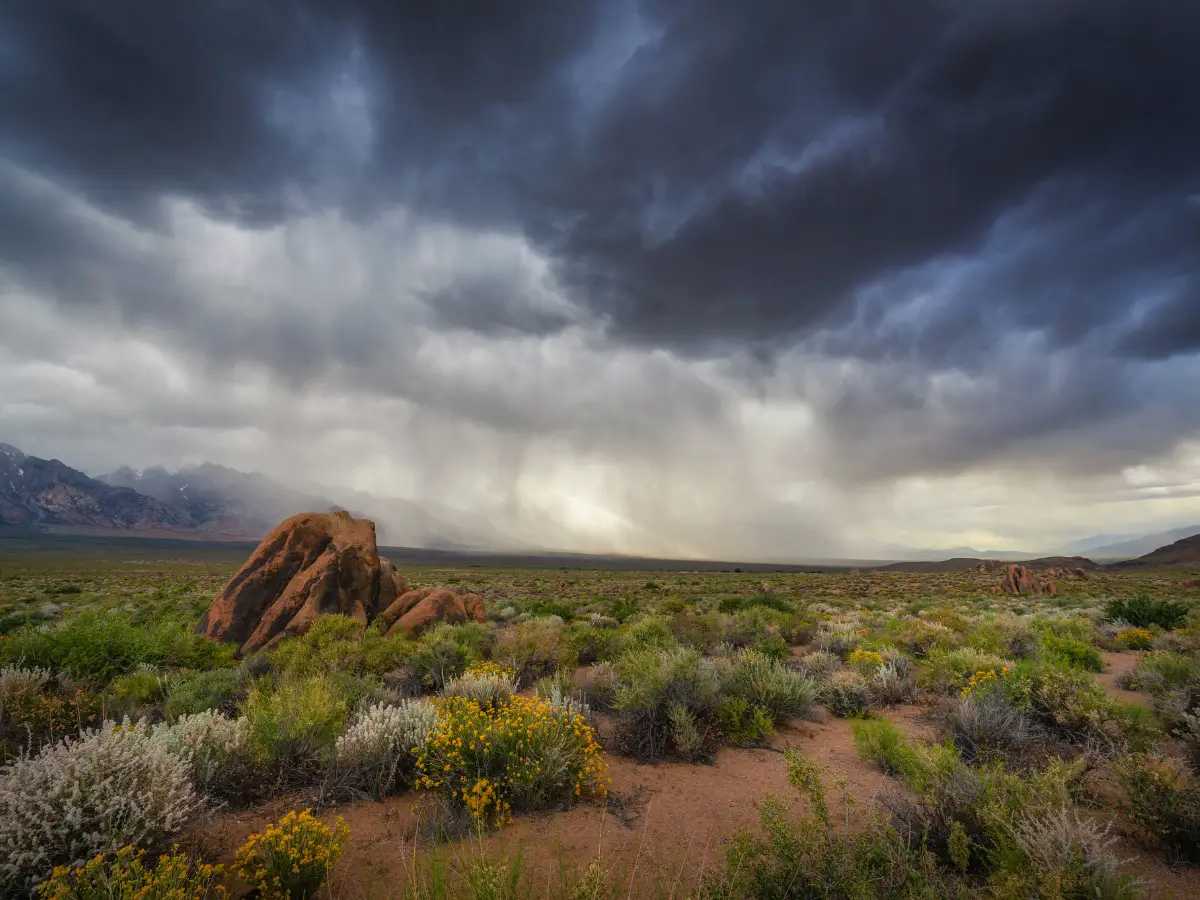California is known for its sunny beaches, warm weather, and picturesque landscapes. However, one question that many people have is how often it rains in California. The answer to this question is not as straightforward as one might think, as the weather patterns in California can vary significantly depending on the location and time of year.
Generally speaking, California experiences a Mediterranean climate characterized by mild, wet winters and hot, dry summers. However, the amount of rainfall can vary widely depending on the region. For example, the northern part of the state tends to receive more rainfall than the southern part, with some areas receiving up to 50 inches of rain per year.
Additionally, specific regions, such as the Central Valley, experience a well-defined dry season in the summer, while others, such as the Sierra Nevada mountain range, receive significant amounts of snowfall during the winter months.

Climate and Geography of California
California is a state located in the western United States, with a diverse climate and geography. The state has a latitude range of 32.5°N to 42°N, which contributes to its varying climate types. California is known for its Mediterranean climate, but it also has arid, semi-arid, desert, and continental climates.
Northern California Climate
Northern California has a Mediterranean climate, which is characterized by mild, wet winters and dry summers. The average temperature ranges from around 9 °C (48 °F) in December to 14.5 °C (58 °F) in August. The region receives the majority of its rainfall from November to April, with an average annual precipitation of 15 to 50 inches, depending on the location and type of landscape.
Southern California Climate
Southern California has a Mediterranean climate as well, but it is warmer and drier than Northern California. The average temperature is in the mid-60s F (about 18 °C) in Los Angeles, with an annual precipitation average of about 14 inches (350 mm). In San Francisco, temperatures average in the mid-50s F (about 14 °C), with annual precipitation of about 20 inches (508 mm).
Central Valley Climate
The Central Valley of California has a continental climate, with hot, dry summers and cool, wet winters. The region is known for its agricultural production, but it is also known for its extreme temperatures. During the summer months, temperatures can reach over 100°F (38°C), while winter temperatures can drop below freezing. The region receives the majority of its rainfall from November to April, with an average annual precipitation of 10 to 20 inches.
Overall, California’s climate and geography are diverse, with varying temperature ranges, precipitation levels, and landscapes. The state’s location on the Pacific coast and its elevation contribute to its unique climate types.

Rainfall Patterns in California
California is known for its diverse landscape and weather patterns. While the state experiences rain throughout the year, the amount and frequency of rainfall varies depending on the region.
Northern California
Northern California is generally wetter than the southern part of the state. The rainy season in Northern California typically starts in November and lasts until April, with the winter months of December and January being the wettest. The average annual precipitation in cities like San Francisco and Sacramento is around 23 inches.
Southern California
Southern California, on the other hand, has a Mediterranean climate with mild, wet winters and hot, dry summers. The rainy season in Southern California usually starts in November and lasts until May, with the winter months of December and January being the wettest. The average annual precipitation in cities like Los Angeles and San Diego is around 14 inches.
Coastal Regions
The coastal regions of California receive more rainfall than the inland areas. The temperature gradient between the immediate coast and low-lying inland valleys in the south is about 7 °F (4 °C) in winter, with the coast being warmer. In summer, the gradient is roughly 20 °F (11 °C), with the interior being warmer.
Weather Patterns
The amount of rainfall in California is influenced by two primary weather patterns: El Niño and La Niña. El Niño typically brings wetter-than-average conditions to California, while La Niña is associated with drier-than-average conditions. However, as seen in 2022, weather patterns can be unpredictable, and California experienced a wetter-than-average year despite the presence of La Niña.
In conclusion, California experiences rain throughout the year, with the amount and frequency varying depending on the region. The rainy season in Northern California typically starts in November and lasts until April, while the rainy season in Southern California usually starts in November and lasts until May. The coastal regions receive more rainfall than the inland areas, and the amount of rainfall is influenced by weather patterns such as El Niño and La Niña.

City Wise Rainfall Distribution
California is known for its diverse geography, which influences the state’s climate and precipitation patterns. The state’s rainfall varies greatly from year to year and from region to region. In this section, we will take a look at the average yearly precipitation for some of California’s major cities.
Northern California
Cities in Northern California generally receive more rainfall than cities in Southern California. The city of Eureka, located on the coast of Northern California, receives the highest average yearly rainfall of any city in California, with an average of 40.5 inches per year. Other cities in Northern California that receive high amounts of rainfall include Santa Rosa (32.3 inches), Ukiah (35.2 inches), and Clearlake (35.7 inches).
Central California
Cities in Central California, which includes the San Joaquin Valley, receive less rainfall than cities in Northern California but more than cities in Southern California. Fresno, located in the San Joaquin Valley, receives an average of 11.5 inches of rainfall per year. Other cities in Central California that receive moderate amounts of rainfall include Stockton (13.7 inches), Modesto (12.2 inches), and Merced (10.4 inches).
Southern California
Cities in Southern California receive the least amount of rainfall in the state. Los Angeles, the largest city in California, receives an average of 14.8 inches of rainfall per year. Other cities in Southern California that receive low amounts of rainfall include San Diego (10.3 inches), Santa Ana (13.8 inches), and Riverside (10.7 inches).
It is important to note that the amount of rainfall a city receives can vary greatly from year to year, and some years may experience drought conditions. Additionally, the state’s water supply is heavily reliant on snowpack in the Sierra Nevada mountains, which can also vary greatly from year to year.
In conclusion, while Northern California generally receives more rainfall than Southern California, the amount of rainfall a city receives can vary greatly from year to year. It is important for California residents to be aware of the state’s precipitation patterns and to conserve water during times of drought.
Impact of Rainfall on California
California’s climate is diverse, but it is mostly characterized by hot, dry summers and mild, wet winters. The state’s climate is significantly influenced by high-pressure systems that develop over the eastern Pacific Ocean. These systems, known as the Pacific High, are responsible for California’s dry weather during the summer months and wet weather during the winter months.
Rainfall is crucial for California’s water supply, and it plays a significant role in the state’s economy, agriculture, and environment. The state has been experiencing a severe drought for several years, which has led to water shortages, wildfires, and agricultural losses. However, the recent rainfall has brought relief to the drought-stricken state.
According to the National Oceanic and Atmospheric Administration, the average yearly precipitation in California is around 22 inches. However, the state’s precipitation varies significantly from year to year, and it is highly dependent on the El Niño and La Niña weather patterns. During El Niño years, California experiences wetter than average winters, while during La Niña years, the state experiences drier than average winters.
Rainfall also affects California’s temperature and wildfire risk. During wetter years, the state’s temperature tends to be cooler, and the wildfire risk is lower. However, during drier years, the state’s temperature tends to be hotter, and the wildfire risk is higher.
In addition to affecting temperature and wildfire risk, rainfall also affects California’s foggy conditions. During wetter years, the state experiences more foggy days, while during drier years, the state experiences fewer foggy days.
Overall, rainfall is critical for California’s water supply, agriculture, and environment. While the recent rainfall has brought relief to the drought-stricken state, it is crucial to continue monitoring the state’s precipitation and water supply to ensure the state’s sustainability.
Comparison of California Rainfall with Other Regions
California is known for its mild, Mediterranean climate, with varying amounts of rainfall depending on the region. While some parts of the state receive very little precipitation, others receive much more. How does California’s rainfall compare to other regions around the world?
France
France is known for its diverse climate, with varying amounts of rainfall depending on the region. The northern part of the country tends to be cooler and wetter, while the southern part is warmer and drier. Paris, the capital of France, receives an average of 24 inches of rainfall per year, while Nice, a city in the south, receives only 25 inches. In comparison, some parts of California receive less than 10 inches of rainfall per year, while others receive over 100 inches.
Golden State
California, also known as the Golden State, has a diverse climate due to its large size and varying topography. The northern part of the state tends to be cooler and wetter, while the southern part is warmer and drier. San Francisco, a city in northern California, receives an average of 23 inches of rainfall per year, while Los Angeles, a city in southern California, receives only 15 inches. In comparison, some parts of the state, such as the Sierra Nevada mountain range, receive over 100 inches of rainfall per year.
Overall, California’s rainfall varies widely depending on the region, with some areas receiving very little precipitation and others receiving much more. While some regions of the world may receive more rainfall on average, California’s diverse climate and topography make it a unique and interesting place to study weather patterns.
Role of Meteorologists in Predicting Rainfall
Meteorologists play a crucial role in predicting rainfall in California. They use various tools and techniques to analyze weather patterns, atmospheric conditions, and historical data to provide accurate forecasts.
One of the primary tools used by meteorologists is computer models. These models take into account various factors such as temperature, humidity, pressure, and wind speed to predict the likelihood of rainfall. Meteorologists also use satellite imagery, radar data, and ground observations to supplement their analysis.
However, predicting rainfall accurately is not an easy task. There are many variables that can affect the outcome, such as the location, intensity, and duration of the rainfall. Meteorologists must also consider the topography of the region, as well as the influence of nearby bodies of water and mountain ranges.
To improve the accuracy of their forecasts, meteorologists often work in teams and collaborate with other professionals such as hydrologists, climatologists, and emergency responders. They also use advanced technology such as drones, weather balloons, and unmanned aircraft to gather data and monitor weather conditions.
In conclusion, meteorologists play a crucial role in predicting rainfall in California. Their expertise and knowledge of weather patterns and atmospheric conditions are essential for providing accurate forecasts and ensuring the safety of the public.
Frequently Asked Questions
What is the average annual rainfall in California?
The average annual rainfall in California varies greatly depending on location. Northern California typically receives between 15 and 50 inches of rain per year, while the southern part of the state receives less, with some areas receiving as little as 5 inches per year.
Which month typically sees the most rainfall in California?
In general, the winter months of December through February see the most rainfall in California. However, there can be variation depending on location and weather patterns.
How many days of rain can be expected in California in a typical year?
The number of days of rain in California varies depending on location and year. In general, most areas of the state can expect between 30 and 60 days of rain per year.
How does the amount of rainfall in Southern California compare to Northern California?
Southern California typically receives less rainfall than Northern California. The southern part of the state is generally drier and receives less than 20 inches of rain per year, while the northern part of the state can receive up to 100 inches in some areas.
How common is rain in Los Angeles?
Rain is not as common in Los Angeles as it is in other parts of California. On average, Los Angeles receives only about 15 inches of rain per year, with most of it falling during the winter months.
What is the rainiest month in California?
The rainiest month in California varies depending on location. In general, the winter months of December through February see the most rainfall in most parts of the state. However, there can be variation depending on location and weather patterns.





